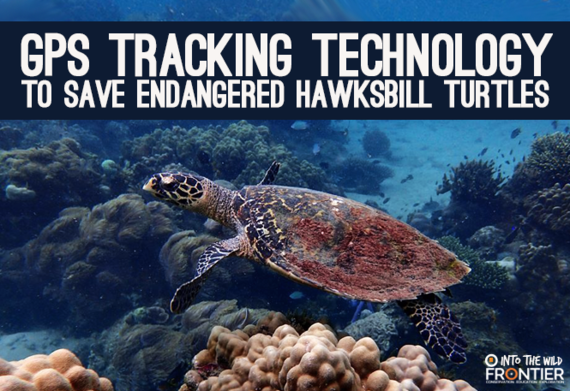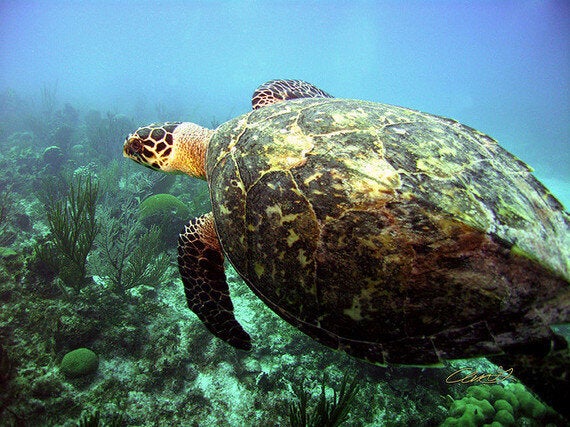
Sometimes it feels like the world is advancing at an unprecedented rate, but that isn't always a bad thing and in this case it is actually very positive. In April, the Nature Conservancy and scientists in the Arnavon Community Marine Conservation area tagged ten endangered Hawksbills with GPS trackers and have been collecting data on them ever since.
The Arnavon area consists of a group of four isolated islands within the Solomon Islands. The area currently supports between 300 and 600 nesting females but according to Richard Hamilton of the Nature Conservancy, poaching in this area has been getting increasingly worse.
Hawksbill Turtles, so named because of their distinctive pointed beaks, are already dangerously close to becoming extinct and so the findings from this research project will no doubt become vital in the restoration of these underwater creatures. As it stands currently, it is legal for people to harvest Hawskbills for subsistence but despite the fact that national law bans the sale of their products and international trade is also illegal, shell products can still be found for sale across the islands.
Previously, tracking Hawksbills has been incredibly difficult due to the fact that they only come ashore every two to seven years to nest and typically only gather in small concentrations. Should the new GPS tracking technology prove to be a success, these difficulties should be a thing of the past and in the future, rather than working out how to gather the necessary information, researchers will be able to simply work to preserve the species.

The Sea Turtle Conservancy has estimated that there are between 20,000 and 23,000 turtles nesting worldwide but despite these figures, the overall population is expected to be down by ten percent of what they were a mere century ago. The decrease is thought to be down to a number of different factors as the Hawksbills face a frequent range of threats; from the illegal trading of their shells, to the poaching of their eggs, to beach erosion, to the degradation of the coral reefs that they feed within. The Hawksbills are being battered from every side with by human developments and the ever worrying threat of poachers still hangs eerily over their future, so it is about time something began to be done to help them.
Unfortunately two of the female Hawksbills that were tagged as a part of the research project were killed by poachers, but data from the other eight has already provided a wealth of information on the movements of the turtle species and has given researchers a much clearer insight into the feeding and nesting patterns of the turtles.
So far the research has highlighted a number of interesting characteristics that the turtles share with one another:
• The sea turtles rarely stay in one place and actually seem to island hop between two main areas on the Kerehikapa and Sikopo Islands. Since discovering this previously unknown fact, rangers have been doubled on the islands to increase the protection in place for those turtles that come ashore.
• Despite this island hopping tendency, most of the nesting actually occurs on Sikopo Island and researchers have concluded that this is probably due to recent storm surges and rising sea levels that have left the Kerehikapa beaches largely eroded.
• Monitoring during the nesting period has shown that the turtles are spending a vast majority of the two week period laying their eggs between the protected area boundaries.
• Interestingly, despite sharing some characteristics across the species, the GPS tracking has shown that migration patterns between individuals actually vary drastically. While one turtle remained in the Solomons, many others swam to Australia and others returned to home territory just a few months later.

As it stands at the moment, the project is still very much in the early stages but there are already hopes to expand the turtle-tagging program in the future, especially as such informative results have already been collected in a matter of months. The hope is that if, or when, the program is expanded scientists and conservationists alike will be able to come to understand the movements of the Hawksbill turtles more accurately and devise successful plans for their protection.
For the time being, the eight remaining tagged turtles will continue to provide invaluable information to the team recording their data. Meanwhile, conservation groups in the area plan to continue to inform the local people of the importance of the turtles and the devastating impact that the trade is having on the overall populations of the Hawksbills. Hamilton himself believes that if the community can be persuaded to take an active part in the preservation of the species, from the tagging of the turtles to the monitoring of the beaches, that the future will beam much brighter for these elusive yet beautiful sea creatures.
If you would like to get involved in turtle conservation, take a look at our project in Costa Rica!
By Shannon Clark - Online Journalism Intern
Frontier runs conservation, development, teaching and adventure travel projects in over 50 countries worldwide - so join us and explore the world!
See more from our volunteers #Frontiervolunteer
